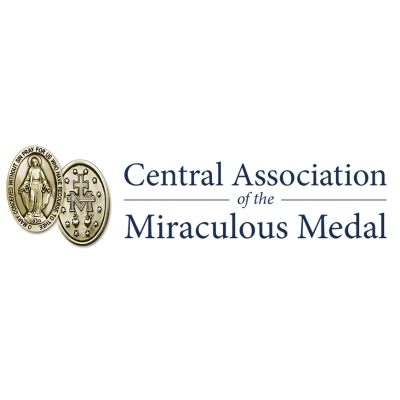Divine Composition
Divine Composition, The Perpetual Novena
It has been called the prayer, the Divine Composition, heard around the world. As stewards of Mary and her Basilica Shrine of Our Lady of the Miraculous Medal, the Vincentians of the Eastern Province celebrate 90 years of upholding the tradition of praying the Novena uninterrupted every Monday.
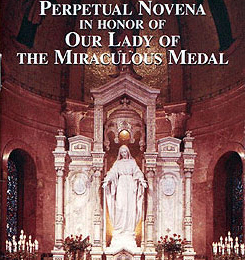
THE FRENCH REVOLUTION
It was an age of unbelief and hostility to religion. France was still recovering from the Revolution, which decimated churches, monasteries, and religious communities throughout the country. The Reign of Terror (roughly 1792-1794) was responsible for killing more than 16,500 people suspected of being “enemies of the Revolution.” By 1830, the Vincentians and the Daughters of Charity, like many religious congregations, had lost so many members they “were only a remnant, two very small communities comprised of the survivors of the Revolution.”
ST. CATHERINE LABOURE AND THE MIRACULOUS MDEAL
It was in this situation that our Blessed Mother brought the splendor of heaven to a quiet and humble Daughter of Charity, Catherine Labouré on November 27, 1830. This was not her first visit to Catherine (the first occurred in July 1830), but it was the occasion in which Catherine received her heavenly commission: to make and distribute the Miraculous Medal to the faithful. (Click here to read “A Medal that Changed the World”)
During the apparition, Mary instructed Catherine to “have a medal struck after this model. Persons who wear it will receive great graces especially if they wear it around the neck.”
CHILDREN OF MARY
Catherine brought Our Lady’s request to Fr. Jean-Marie Aladel, a Vincentian priest and her spiritual director. This was the second time Catherine approached him with a message. In Mary’s July apparition, she told Catherine that she requested Fr. Aladel to found and direct a confraternity of “Children of Mary.”
As its name implies, the confraternity would comprise children who imitated the virtues of our Blessed Mother—especially purity, charity, humility, and obedience—and honored Mary through acts of devotion. Although it took him several years to respond to this request, Fr. Aladel finally created the confraternity and then asked the Pope to establish it as a pontifical association. The Pope agreed and granted it all the indulgences entitled to an association of its kind. The Daughters of Charity were already promoting it, but now, as Mary had promised, God blessed the work so abundantly that the Children of Mary rapidly spread throughout France.
In 1909, the Vincentians began promoting it as well, and they asked their Superior General and the Pope for authorization to start something similar for adults. In addition to honoring our Blessed Mother, the members of this new confraternity would “wear the Miraculous Medal and honor it with a Christian and apostolic life, each member doing so according to his/her state of life. Working together, they [would] seek to foster a more perfect life in communion with others, and accomplish apostolic activities through spreading the 1830 message of the Blessed Virgin to [Saint] Catherine Labouré.” On July 8, this new venture, the Association of the Miraculous Medal, was officially approved by Pope St. Pius X. Having Papal recognition for both organizations, the Vincentians could now disseminate the Medal and devotion to it at an accelerated pace.
A GERMANTOWN MIRACLE
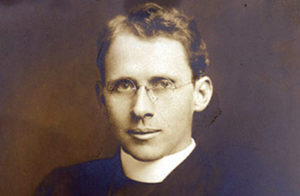 A mere five years later, Fr. Joseph Skelly, CM (pictured), was sitting at his desk surrounded by stacks of fund-raising letters he had written to build St. Joseph’s Seminary in Princeton, New Jersey. While putting the letters in the envelopes, he did something that, on the surface, could appear rather insignificant. He inserted a small Miraculous Medal in each envelope, imploring Mary to bless his efforts. Surely, he counted on her intercession, but he didn’t expect the response he received. It was overwhelming-a true sign of Mary’s intervention. Fr. Skelly was so grateful, he wanted to find a special way to thank her. Little could he have imagined that his next actions would create a prayer heard round the world.
A mere five years later, Fr. Joseph Skelly, CM (pictured), was sitting at his desk surrounded by stacks of fund-raising letters he had written to build St. Joseph’s Seminary in Princeton, New Jersey. While putting the letters in the envelopes, he did something that, on the surface, could appear rather insignificant. He inserted a small Miraculous Medal in each envelope, imploring Mary to bless his efforts. Surely, he counted on her intercession, but he didn’t expect the response he received. It was overwhelming-a true sign of Mary’s intervention. Fr. Skelly was so grateful, he wanted to find a special way to thank her. Little could he have imagined that his next actions would create a prayer heard round the world.
CAMM
He began by establishing an organization, the Central Association of the Miraculous Medal (CAMM) (Click here to read “I Am CAMM”), whose primary purpose was promoting Mary and her Miraculous Medal. Then, with generous help from CAMM’s members, he built a stunning shrine dedicated to Mary within the Immaculate Conception chapel attached to St. Vincent de Paul’s Seminary.
THE MIRACULOUS MEDAL NOVENA
THE PERPETUAL NOVENA
His next step was to honor Mary and her Miraculous Medal publicly, with a Novena before each of her four major Feast Days: Our Lady of the Miraculous Medal (November); Our Lady of Lourdes (February); Our Lady, Help of Christians (May); and the Assumption (August).
But the Miraculous Medal was such a new feast in the Church, there wasn’t a novena associated with it. So Vincentian Frs. Joseph Skelly, Kieran Moran, and Michael Drennan worked to develop one. They used prayers from the Raccolta (the official collection of the Church’s indulgenced prayers and devotions), like the Preparatory Prayer for the Feast of the Immaculate Conception, the Memorare, the prayer of the Miraculous Medal (O Mary, conceived without sin, pray for us who have recourse to thee), and one of St. Alphonsus Liguori’s prayers. Thus, in 1927, the Novena in honor of Our Lady of the Miraculous Medal was introduced to the faithful in Germantown, and later the world.
EVOLUTION OF THE PRAYERS
Originally, it was recited in a service consisting of the prayers, a 15- to 20-minute sermon, a hymn, and Benediction. The Novenas were popular, and soon our Blessed Mother was showering favors on the people who attended. Fr. Skelly started getting letters reporting large and small favors, remarkable and everyday graces, received from Mary’s hands: eyesight restored, health regained, employment found, accidents averted, and family members returning to the faith.
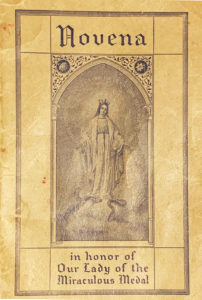
Three years later in 1930, Fr. Skelly wanted to broaden the devotion to Mary, who was clearly interceding powerfully for her children. That year also happened to mark the centenary of our Blessed Mother’s appearances to St. Catherine Labouré. The timing was perfect. In November’s Novena to Our Lady of the Miraculous Medal, he added two more services to the last three days of the Novena, creating a Triduum (three days) of prayer for people who were not able to attend the full nine-day Novena.
During the Triduum, Fr. Skelly announced the inauguration of a Perpetual Novena to Our Lady of the Miraculous Medal, which would be held every Monday of the year at 8:00 p.m. This new Novena would begin on December 8, the Feast of the Immaculate Conception. Letters were sent to CAMM members who lived in the Philadelphia area, who encouraged their friends and family members to attend.
STRUCTURE OF THE NOVENA
Fr. Skelly insisted the new Novena format be no longer than a half hour and would still include Benediction, prayers, and a short sermon. Once again, Frs. Drennan and Moran came to Fr. Skelly’s aid, keeping some of the old Novena prayers and gathering new ones from the Raccolta. It was Fr. Moran who composed the “Act of Consecration” prayer.
AN OVERNIGHT SENSATION
The Monday Novena services were such a success that soon diocesan priests asked permission to celebrate the Perpetual Novena in their parishes. In the July 1931 issue of the Miraculous Medal Magazine, Fr. Skelly wrote:
“The Perpetual Novena of Monday nights has grown marvelously popular. Every Monday night, the crowds are so great that the capacity of the Chapel of the Immaculate Conception, at Chelten and Magnolia Avenues, is overtaxed, though the Chapel is as large as any ordinary church. And, the fervor of the crowds, their praying and their singing in unison, and the many favors reported, are more extraordinary even than the great multitudes who come, rain or shine, to ask their generous Mother to help them in time of need.”
GOING NATIONWIDE
By 1934, there were eighty-nine parishes in the United States offering the Perpetual Novena: thirty-five in the city of Philadelphia, twenty-two in the Archdiocese of Philadelphia, four in other areas of Pennsylvania, seven in New York, seven in New Jersey, and the remaining fourteen spread out in Connecticut, Delaware, Ohio, the District of Columbia, Maryland, Michigan, and West Virginia. One pastor wrote to Fr. Skelly telling him that within six months of starting the Novena, “apart from many blessings conferred on the parish in general, fifty-four special favors have been received by individuals, which they attribute to the intercession of Our Blessed Lady under the title of the Miraculous Medal.” Another priest wrote that the Miraculous Medal Novena “is the answer to Communism.”
Three years later, 842 churches held Perpetual Novena services. Twenty years after it started, the Novena had spread to more than 3,300 churches and chapels throughout the world9 and was translated into various languages—including Braille.
90 YEARS UNBROKEN
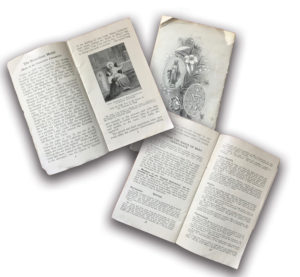 Just as impressive, the Perpetual Novena has remained unbroken in the past 90 years—winter storms, summer heat, and even the pandemic—could not stop the Novena. When the Basilica Shrine was temporarily closed during of the pandemic, we still placed Mary’s resplendent crown on her head for the month of May (read the article on page 7); we continued to pray the Novena prayers every Monday; we still livestreamed our (private) Monday Masses, which were offered in the St. Vincent’s Seminary for the sick and dying front-line workers and caregivers, those affected by the coronavirus, each person who sent their intentions to us, and, of course, for an end to the pandemic.
Just as impressive, the Perpetual Novena has remained unbroken in the past 90 years—winter storms, summer heat, and even the pandemic—could not stop the Novena. When the Basilica Shrine was temporarily closed during of the pandemic, we still placed Mary’s resplendent crown on her head for the month of May (read the article on page 7); we continued to pray the Novena prayers every Monday; we still livestreamed our (private) Monday Masses, which were offered in the St. Vincent’s Seminary for the sick and dying front-line workers and caregivers, those affected by the coronavirus, each person who sent their intentions to us, and, of course, for an end to the pandemic.
We also placed a vigil lamp at the foot of Mary’s statue in the Shrine, along with the intentions of everyone who contacted CAMM or the Basilica Shrine. We posted daily videos of the Vincentians’ prayers on our website and social platforms. We united our prayers to yours, lifted your intentions to Mary, Comforter of the Afflicted, and asked for immense graces, because our God gives graciously through her.
The Vincentians, who were quarantined at the Seminary, also combined their efforts to create a lovely outdoor altar to Mary, where they went to pray their rosaries, read scripture, or meditate—and they encouraged others to build their own “Mary altars” at home.
SOLIDARITY OF PRAYER
Even in the midst of the pandemic and social unrest we’ve experienced, we know the solution is a greater love for our Blessed Mother and her Divine Son—a love that plays itself out by helping our neighbors and “the least among us.” The solution is the Miraculous Medal, not as an object of art or jewelry, but as something we wear close to our hearts to remind us of her pledge to us and our pledge to her (see the article, “A Medal That Changed the World,” on pages 20-23). The solution is prayer: prayer to Jesus through Mary and her Perpetual Novena.
In July 1931, Fr. Skelly wrote:
“Of course thousands who live at a distance make these Novenas in their own churches or in their homes, joining their intentions with those of the thousand or more people who every Monday night fill every seat and practically every foot of standing room in the Chapel. And in this sense, assuredly, you can ‘pay us a visit’ during these summer months. Indeed, we particularly desire our readers and Members to join in heart and spirit in these Monday night Novenas. We ask them to pray for the intentions of all who are making the Novena, whether at the Shrine or at home. And those who make the Novena at the Shrine are asked invariably to pray for the intentions of the thousands of others who cannot come. We need this solidarity of prayer. …There is no force [as] mighty as that of thousands of united hearts, joined in faith and love, asking Mary’s intercession.”
THE ROMANCE OF THE NOVENA
Six years later, he wrote that the romance of the Perpetual Novena is all about loving and honoring the “dearest of all women, our Mother, and the fairest of all mothers.” He called the Miraculous Medal Novena “a love theme” and attributed its attraction to not only seeking Mary’s gifts, “but Mary herself.”
While Fr. Moran acknowledged the love story between Mary and her children, he approached it from a slightly different viewpoint. In one of his Perpetual Novena sermons, Fr. Moran told the congregation that when we pray the Novena to our Blessed Mother, she makes a Novena to us. She comes to each of us individually and asks us to turn to her in prayer. She comes to each one of us and asks us to turn away from the things that are destroying or enslaving us. She comes and asks each one of us to turn our life into a generous gift for others.
If you can, come to Mary at The Miraculous Medal Shrine in Germantown, turn to her, and pray the Novena with us. Our Blessed Mother showers extraordinary graces here, “remarkable cures of soul and body,” as Fr. Skelly once said. However, if distance prevents you from visiting the Shrine in person, watch our Masses online and unite your Novena prayers with ours—this not only touches Mary’s maternal heart, it also makes our prayers more powerful.
Accordingly, we Priests at the Shrine, who have witnessed the rise and swelling flow of the Novena stream for twenty years, take no personal glory for its success. We say rather, “The hand of God is here.”
And in return, the investment of the few minutes we give her in praying the Novena will yield us “such rich returns in so many ways,” as Fr. Moran said in one of his sermons, “you may look upon it as a weekly deposit in the Bank of Our Lady; a deposit that she loves to receive, that she safeguards jealously; a deposit that she invests wisely so that the interest upon it may come to you in those crises of our lives when you need it most.”
Although his sermons date back almost ninety years, Fr. Moran’s words remain relevant:
“Oh my friends, in these days of evil, in these times where fierce enemies are threatening to destroy us, when so many forces are leagued together to battle against our faith, to destroy all the decencies of life, why do we not give the strong Mother of God the chance that she desires to protect us? …It may well be that God has inspired these Novena devotions in honor of Mary in order that through them we may find effective protection against whatever may come to pass.”
